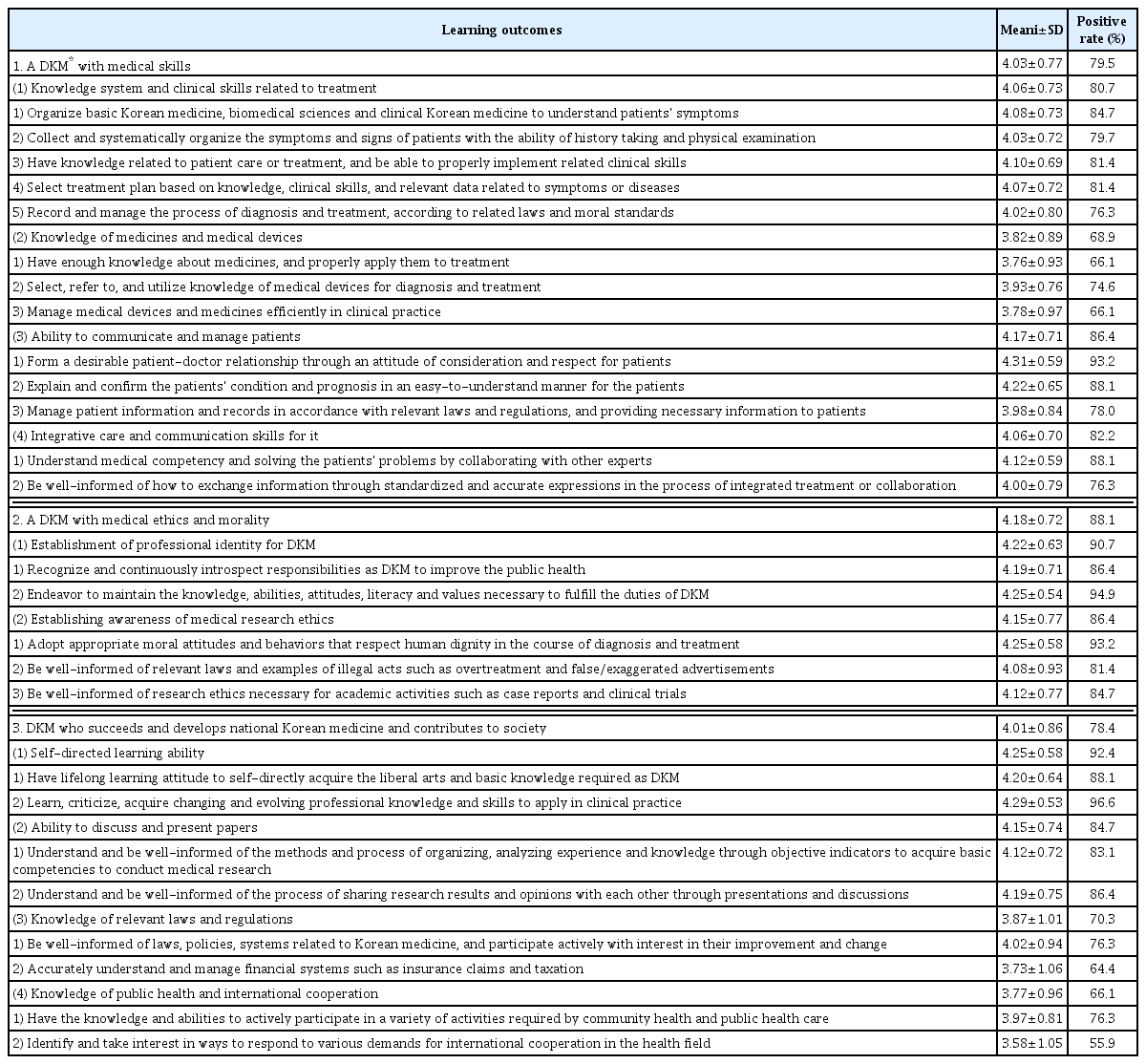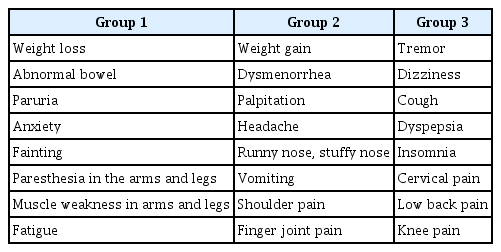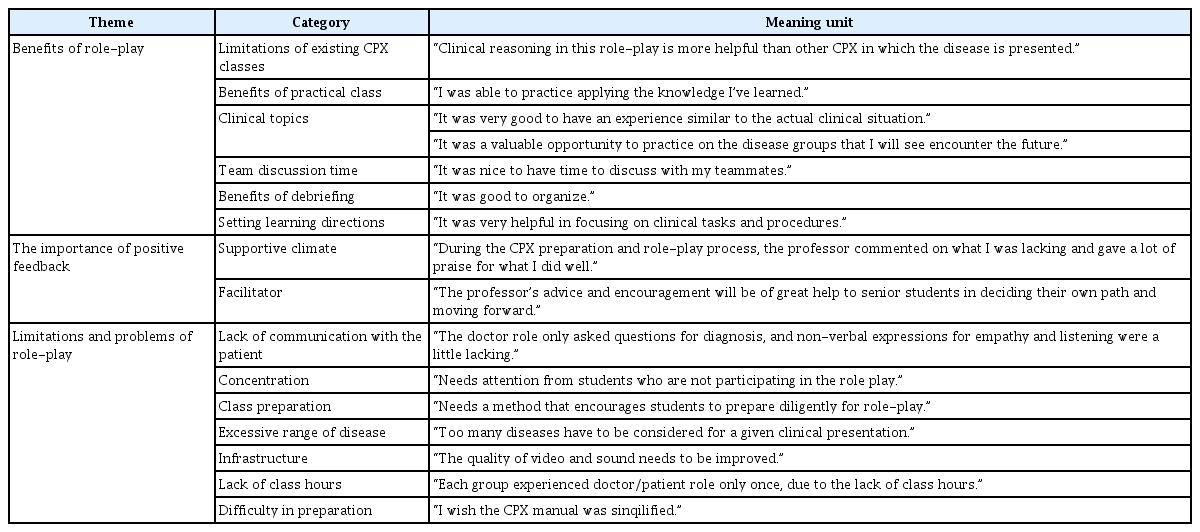References
1. Park Y.-H., Huang D.-S., Shin H.-K.. 2011;A survey of the medical treatment environment in traditional Korean medicine clinics. Journal of Korean Oriental Medicine 32(4):25–36.
2. Lim C., Han H., Hong J., Kang Y.. 2016;2016 Competency Modeling for Doctor of Korean Medicine & Application Plans. Journal of Korean Medicine 37(1):101–113.
https://doi.org/10.13048/jkm.16010
.
3. Huggett K.N., Jeffries W.. 2019. An introduction to medical teaching 2nd edth ed. Gyeongsan (Korea): Yeungnam University Press.
4. Harden R.M., Laidlaw J.M.. 2017. Essential skills for a medical teacher: An introduction to teaching and learning in medicine Paju (Korea): Academypress.
5. Jo H., Min S.. 2020;The current status and future operations of Clinical Performance Evaluation (CPX) in the nationwide colleges (graduate schools) of Traditional Korean Medicine. The Journal of Korean Medical History 33(2):9–21.
https://doi.org/10.15521/JKMH.2020.33.2.009
.
6. Collins J.P., Harden R.M.. 1998;AMEE Medical Education Guide No.13: Real patients, simulated patients and simulators in clinical examinations. Medical Teacher 20(6):508–521.
https://doi.org/10.1080/01421599880210
.
7. Bosse H.M., Nickel M., Huwendiek S., Jünger J., Schultz J.H., Nikendei C.. 2010;Peer role-play and standardised patients in communication training: A comparative study on the student perspective on acceptability, realism, and perceived effect. BMC Medical Education 10(1):27.
https://doi.org/10.1186/1472-6920-10-27
.
8. Harden R.M., Lilley P., Patricio M.. 2016. The definitive guide to the OSCE: The Objective Structured Clinical Examination as a performance assessment Edinburgh (UK): Elsevier.
9. Gelis A., Cervello S., Rey R., Llorca G., Lambert P., Franck N., Dupeyron A., Delpont M., Rolland B.. 2020;Peer Role-Play for Training Communication Skills in Medical Students: A Systematic Review. Simulation in Healthcare: The Journal of the Society for Simulation in Healthcare 15(2):106–111.
https://doi.org/10.1097/SIH.0000000000000412
.
10. Song M.-K., Hong S.-U.. 2012;A survey of students’ satisfaction on participation learning using role-play in clerkship. The Journal of Korean Oriental Medical Ophthalmology & Otolaryngology & Dermatology 25(3):65–77.
https://doi.Org/10.6114/JKOOD.2012.25.3.065
.
12. Kim K.-S., Jeong S.-Y., Kim K.-O.. 2019;A study on the level of communication and clinical skills of Korean medical students by the participatory method of role playing. Journal of Oriental Neuropsychiatry 30(3):177–184.
https://doi.org/10.7231/JON.2019.30.3.177
.
13. Kim K.-O., Kim H.-K., An H.-J., Shin H.-T.. 2013;A study about the medical communication proficiency of Korean traditional medical students using standardized patients with Hwa-Byoung. Korean Journal of Oriental Preventive Medical Society 17(1):163–179.
14. Cho C.S.. 2015;Student Satisfaction Study and Interrater Comparative Study on Patient-Physician Interaction Score of Clinical Performance Examination in Korean Medical Education. Korean Journal of Oriental Physiology & Pathology 29(2):152.
http://doi.org/10.15188/kjopp.2015.04.29.2.152
.
15. Kweon J.H., Sim S.B., Kim E.J., Hong J.W., Shin S.W.. 2018;Evaluation of the Implementation of Clinical Performance Examination in Korean Medicine Education. Journal of Physiology & Pathology in Korean Medicine 32(1):51–61.
https://doi.org/10.15188/kjopp.2018.02.32.1.51
.
16. Park K.-M., Cho S.-H., Yang S.-J., Shin H.-T., Choi Y.-J.. 2019;A Study about the Medical Communication Proficiency of Korean Traditional Medical Students Using Standardized Patients of Menopausal Disorder. The Journal of Korean Obstetrics and Gynecology 32(2):100–118.
https://doi.org/10.15204/JKOBGY.2019.32.2.100
.
17. Han C.-Y., Kang D.-W., Park J.-G., Kim B.-H., Kim K.-S., Kim Y.-B., Nam H.-J.. 2020;An analysis of clerkship satisfaction in college of Korean medicine. J Korean Med Ophthalmol Otolaryngol Dermatol 33(1):12–24.
https://doi.org/10.6114/JKOOD.2020.33.1.012
.
18. Jo H.-J., Park J.-S., Roh J.D., Sung H.K.. 2020;A Survey on Students’ Perception of Clinical Performance Examination (CPX) in College of Korean Medicine Using Student Standardized Patients. Society of Preventive Korean Medicine 24(3):1–13.
https://doi.org/10.25153/SPKOM.2020.24.3.001
.
19. Jo H.-J., Jo N.-Y., Roh J.-D., Park J.-S.. 2021;A survey on clinical practice students’ perception of clinical performance examination in a college of Korean medicine using the actor standardized patient and student standardized patient. Society of Preventive Korean Medicine 25(3):101–115.
https://doi.org/10.25153/SPKOM.2021.25.3.008
.
20. Tierney L.M., Henderson M.C.. 2010. (The)patient history: Evidence-based approach Seoul (Korea): Korean medical books.
21. Koonja Publish Academic Bureau. 2013. Must have items of CPX+OSCE Paju (Korea): Koonja Publish Company.
22. Globooks Academic Bureau. 2012. REAL CPX Guide Book Paju (Korea): Globooks.
23. National Institute for Korean Medicine Development. Introduction of Clinical Performance examination. National Clearinghouse for Korean Medicine. [serial online] [cited 2022 Feb 28]; Available from: URL:
https://nikom.or.kr/nckm/html.do?menu_idx=123
.
24. Axboe M.K., Christensen K.S., Kofoed P.-E., Ammentorp J.. 2016;Development and validation of a self-efficacy questionnaire (SE-12) measuring the clinical communication skills of health care professionals. BMC Medical Education 16(1):272.
https://doi.org/10.1186/s12909-016-0798-7
.
25. Gil C.-R., Sung K.-M.. 2020;Validity and reliability of the Korean version of self-efficacy questionnaire (KSE-12). Journal of Digital Convergence 18(5):337–345.
https://doi.org/10.14400/JDC.2020.18.5.337
.
26. Mata Á.N.D.S., de Azevedo K.P.M., Braga L.P., de Medeiros G.C.B.S., de Oliveira Segundo V.H., Bezerra I.N.M., Piuvezam G.. 2021;Training in communication skills for self-efficacy of health professionals: a systematic review. Human resources for health 19(1):1–9.
https://doi.org/10.1186/s12960-021-00574-3
.
27. Escribano S., Juliá-Sanchis R., García-Sanjuán S., Congost-Maestre N., Cabañero-Martínez M.J.. 2021;Psychometric properties of the Attitudes towards Medical Communication Scale in nursing students. PeerJ 9:e11034.
https://doi.org/10.7717/peerj.11034
.
28. Wolderslund M., Kofoed P.-E., Ammentorp J.. 2021;The effectiveness of a person-centred communication skills training programme for the health care professionals of a large hospital in Denmark. Patient Education and Counseling 104(6):1423–1430.
https://doi.org/10.1016/j.pec.2020.11.018
.
29. Ha E.-H., Song H.-S.. 2015;The Effects of Structured Self-Debriefing Using on the Clinical Competency, Self-Efficacy, and Educational Satisfaction in Nursing Students after Simulation. The Journal of Korean Academic Society of Nursing Education 21(4):445–454.
https://doi.org/10.5977/jkasne.2015.21.4.445
.
30. Fanning R.M., Gaba D.M.. 2007;The Role of Debriefing in Simulation-Based Learning. Simulation in Healthcare: The Journal of the Society for Simulation in Healthcare 2(2):115–125.
https://doi.org/10.1097/SIH.0b013e3180315539
.
31. Decker S., Fey M., Sideras S., Caballero S., Rockstraw L., Rocky Boese T., Frankhn A.E., Gloe D., Lioce L., Sando C.R., Meakim C., Borum J.C.. 2013;Standards of Best Practice: Simulation Standard VI: The Debriefing Process. Clinical Simulation in Nursing 9(6):S26–S29.
https://doi.org/10.1016/j.ecns.2013.04.008
.
32. Radziej K., Loechner J., Engerer C., Niglio de Figueiredo M., Freund J., Sattel H., Bachmann C., Berberat P.O., Dinkel A., Wuensch A.. 2017;How to assess communication skills? Development of the rating scale ComOn Check: Evaluation of communication skills. Medical Education Online 22(1):1392823.
https://doi.org/10.1080/10872981.2017.1392823
.






































